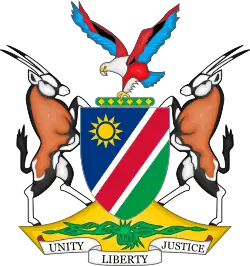China–Namibia relations
People's Republic of China–Namibia relations refer to the bilateral relations between the People's Republic of China and the Republic of Namibia. Governmental relations were first established the day after Namibia's independence, but relations with Namibian independence movements date back to the 1960s.[1]
 | |
China |
Namibia |
|---|---|

Chinese support for independence movements
Beginning in the 1960s, during the Namibian War of Independence, China provided various indigenous Namibian independence movements (at first South West African National Union (SWANU))[2] and later South West Africa People's Organization (SWAPO) with "moral and material support".[1]
China since Namibian independence
PR China and Namibia established relations on 22 March 1990, which was the day after Namibia's independence.[1] The government of Namibia is an adherent to the One-China policy.[3]
Economic relations
China and Namibia have developed close economic relations, with trade increasing two-fold between the two countries from 2003 to 2006.
Chinese development finance to Namibia
From 2000 to 2011, there are approximately 64 Chinese official development finance projects identified in Namibia through various media reports.[4] During a February 2007 visit, Chinese President Hu Jintao pledged Namibia "RMB 1 billion of concessional loans, 100 million US dollars of preferential export buyer's credit, RMB 30 million yuan of grants and RMB 30 million of interest-free loans..."[1] In November 2005, Namibian President Hifikepunye Pohama and Chinese Politburo member Li Chang Chun witnessed the signing of a 250 million Yuan concessional loan by Export-Import Bank of China to be used for purchasing locomotives and trains for a new railway being built in northern Namibia.[5]
Migration
A large number of Chinese are estimated to have taken up residence in Namibia since independence. In 2006, their number was estimated at 40,000.[6]
An Yue Jiang scandal
In April 2008, a weapons shipment on the An Yue Jiang sailed from China destined for Zimbabwe. It was stopped from porting in South Africa because of protests regarding the weapons and the disputed Zimbabwean presidential election which had taken place a month earlier. Seeking a destination for the ship, it was rumored that it would be port on Namibia's coast at Walvis Bay. On 24 April 2008, a protest took place in Namibia's capital of Windhoek, where two hundred protesters marched from a Zoo Park in central Windhoek to the Chinese embassy.[7] Among those leading the protesters were Bishop and SWAPO politician Zephania Kameeta and the Legal Assistance Centre.[7] The ship did not port in Namibia.
Bibliography
- Cardenal, Juan Pablo; Araújo, Heriberto (2011). La silenciosa conquista china (in Spanish). Barcelona: Crítica. pp. 282–283. ISBN 9788498922578.
References
- Interpretation of China-Namibia Relations in Foreign Ministry of the People's Republic of China
- SWANU official web site Archived 2004-11-07 at the Wayback Machine
- President Hu calls for closer China-Namibia ties in China Daily, 20 December 2005
- Austin Strange, Bradley C. Parks, Michael J. Tierney, Andreas Fuchs, Axel Dreher, and Vijaya Ramachandran. 2013. China’s Development Finance to Africa: A Media-Based Approach to Data Collection. CGD Working Paper 323. Washington DC: Center for Global Development.http://china.aiddata.org%5B%5D
- Strange, Parks, Tierney, Fuchs, Dreher, and Ramachandran, China’s Development Finance to Africa: A Media-Based Approach to Data Collection.http://aiddatachina.org/projects/131
- "40,000 Chinese in Namibia". The Namibian. as quoted in the Southern African Migration Project (SAMP). 21 November 2006. Archived from the original on 2012-09-27. Retrieved 21 March 2011.
- Namibians say NO to arms by Tanja Bause, The Namibian, 25 April 2008
External links
- China buys into Berg Aukas New Era 14 January 2011
- WikiLeaks: Namibia Allows Chinese Immigration to Repay Loans Voice of America, 15 December 2010
- China eyes Namibia's minerals Mail & Guardian, 9 April 2010
- Graft Inquiry in Namibia Finds Clues in China The New York Times, 21 July 2009
- No more Namibia: China blocks search results for entire country OpenNet.net, 22 July 2009
.svg.png.webp)
